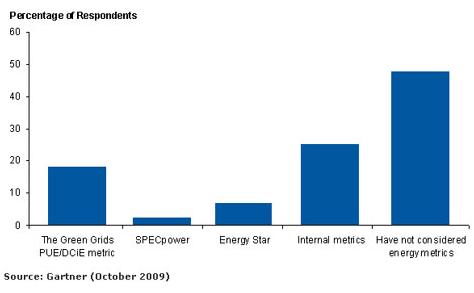The Polarization of the Data Center Industry (at least for now): Part 1 of 2
By Christian Belady,
Principal Infrastructure Architect
Global Foundation Services, Microsoft Corporation
I read a lot about what others are doing in the industry, and a recent post by Rich Miller of Data Center Knowledge caught my attention. It was titled “Gartner: Energy Woes to Worsen in 2010” and he posted a Graph from Gartner showing that only about 50 percent of the IT professionals are using some form of energy metrics in the data center.

At first I was not surprised, because as many of you heard me complain in the past, “this industry is moving too slow when it comes to efficiency”. Clearly, the adoption of efficiency metrics is quite low according to the graph. Less than 18 percent of those surveyed are using PUE/DCiE, less than 3 percent are using SPEC Power and perhaps 7 percent or so are using Energy Star. A little more than 20 percent are using other internal metrics…and I couldn’t help but wonder what they are. Additionally, why are the remaining 50 percent not measuring anything, particularly in a time when sustainability seems to be top of mind for everyone. Why do these folks seem to not care?
Perhaps the answer lies in the fact that maybe the respondents should have been weighted by their relative data center sizes. I would argue that any company – where a bulk of their costs are driven by their IT operations (which by the way are likely to be huge operations such as Microsoft, Yahoo, Ebay, Amazon, Google, etc.) – are further to the left on the graph because it has such a large impact on profitability. Similarly, those who have either small operations or their IT costs are low relative to other costs are further to the right. So in essence, we have a polarization of the data center industry: the Leftists and the Rightists.
The leftists are made up of large internet businesses that live and die with online commerce and consumer services. These guys are obsessed with driving cost out of their operations, are willing to break the rules and standards, believe they can change trends, quickly adopt new ideas, and take risks to substantially change their TCO models for the better. Because of their size, they can also hire specialists to engineer and optimize their data centers to levels never seen before.
Conversely, the rightists are made up of the more traditional enterprises where the IT department is just a very small part of their cost structure. In these organizations, the IT department is just expected to be there. It’s a cost that people accept because it is small and as long as there are no issues everyone is happy. The motivation for the operation’s folks is to simply make sure nothing goes wrong. As a result, there are no incentives to improve efficiency (especially if there is a perceived risk) and their priority is uptime. As a result, there is no reason to go to outside air economization, there is no reason to add new processes to monitor and measure efficiency, and there is no reason to look at new data center architectures that could risk downtime. This all makes sense if you look at the following graphs in which I compare two hypothetical companies, one with most of their costs in IT Operations (Leftists) and one with only 10 percent revenue dollars are eaten up by IT operations costs (Rightists):
This shows me why it may be that companies are still not motivated to focus on efficiency. In the case of the Leftist company - spending resources for a 20 percent IT Operations improvement in efficiency would return an improvement of 160 percent in profitability. However, that same improvement in the IT Operations for the Rightist company only yields an improvement of 20 percent in profitability. In their case, it would make sense to focus on improving their other costs. So the reality is we can’t expect everyone to think efficiency is so important! Ultimately it will boil down to how sensitive a business is to the costs of its IT operations. So in the short term, there appears to be this polarization that has occurred. However, to Gartner’s point, this could all change if energy costs increase substantially or carbon taxes emerge. In addition, what would happen if the big online providers (Leftists) hyper-optimized their operations and can offer cloud services at a fraction of the cost of running IT Operations that the Rightists can do themselves? Would this make all of those who did not focus on efficiency move to the cloud to survive?
Gartner’s survey really has made me think about this. In fact, I hope that the next time Gartner runs this survey they also track the following:
1) What percentage of the costs are in IT Operations?
2) How would the business be impacted if IT costs would double or even triple?
Tune in tomorrow for my thoughts on this issue and the “inflection point for efficiency”.
\cb
